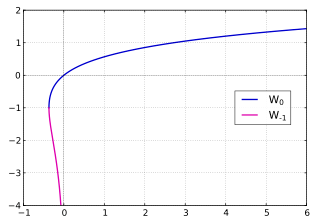
The lambert W function, denoted as , is a special function that is defined as the inverse of the function . In other words, if , then it satisfies the equation:
This is only one way to define the Lambert W function, and there are other equivalent definitions as well.
However, the problem is that the Lambert W function is not defined for all real numbers. It is only defined for certain values of , specifically for , where is the base of the natural logarithm.
Because of this, it cannot technically be called a function in the strictest sense, as it does not have a unique output for every input. Instead, it is a multi-valued function, meaning that for some inputs, there are multiple outputs.
Properties
A neat property of the Lambert W function is that it is the inverse of the function . This means that if , then
Example
Take a number and use it as the input to the function . This returns a constant (duh). If you take this number and multiply it by raised to the power of that number, you get back :
This property is useful in many applications, such as solving equations involving exponentials and logarithms. Namely, it allows us to solve those equations of the form: